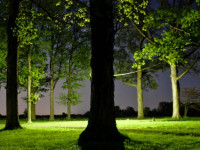Walker Percy, Ontological Lapsometers, and the End of the World
 Modern man is fragmented and hollow at its core. In modern man’s wake there is often destruction and ruin. Walker Percy’s Love in the Ruins is an hilarious romp through the ruins of modern man’s cathedral, set in a place called Paradise, Louisiana as the world seemingly comes to an end. Dr. Thomas More, a backslidden catholic and womanizer, has created an ontological lapsometer that diagnoses and treats human disorders that threaten to disintegrate society. Unfortunately, if the Lapsometer get’s into the wrong hands, it can also lead to chaos and the breakdown of society. In Percy’s story we read of Dr. More’s womanizing exploits as he prepares for the end of the world and tries to keep his invention from falling into the wrong hands.
Modern man is fragmented and hollow at its core. In modern man’s wake there is often destruction and ruin. Walker Percy’s Love in the Ruins is an hilarious romp through the ruins of modern man’s cathedral, set in a place called Paradise, Louisiana as the world seemingly comes to an end. Dr. Thomas More, a backslidden catholic and womanizer, has created an ontological lapsometer that diagnoses and treats human disorders that threaten to disintegrate society. Unfortunately, if the Lapsometer get’s into the wrong hands, it can also lead to chaos and the breakdown of society. In Percy’s story we read of Dr. More’s womanizing exploits as he prepares for the end of the world and tries to keep his invention from falling into the wrong hands.
Two of my favorite scenes from the book are worthy of mention and brief reflection:
(1) Dr. More’s description of the Lapsometer:[1]
If you measure the pineal activity of a monkey—or any other subhuman animal—with the lapsometer, you will invariably record identical readings at Layers I and II. Its self, that is to say, coincides with itself. Only in man do you find a discrepancy: Layer I, the outer social self, ticking over, say, at a sprightly 5.4 mmv, while Layer II just lies there, barely alive at 0.7 mmv, or even zero!—a nought, a gap, an aching wound. Only in man does the self miss itself, fall from itself (hence lapsometer!). Suppose—! Suppose I could hit on the right dosage and weld the broken self whole! What if man could reenter paradise, so to speak, and live there both as man and spirit, whole and intact man-spirit, as solid flesh as a speckled trout, a dappled thing, yet aware of itself as a self!
It is the longing of the human heart to be whole. It is the longing of the human heart to have our willing and thinking (and emoting) pointing in the same direction. This longing for wholeness is what makes Dr. More’s discovery of the ontological lapsometer so comical: if it were only that easy! If wholeness and happiness could be delivered by waiving a machine over our heads! The reality is there is a way to find wholeness; but it will not be through the ontological lapsometer. Rather it is through surrender (oddly) of self to Jesus. In following Christ, we actually are given back our self, free to live for God and man and enjoy the happiness that God provides.
(2) Dr. More’s provisions for the end of the world:[2]
Room 206 [in the abandoned Howard Johnson Hotel) is stacked to the roof with canned food, mostly Vienna Sausage and Campbell’s soup, fifteen cases of Early Times bourbon whiskey, and the World’s Great Books. In the rooms intervening, 203, 204, and 205, are to be found Ellen, Moira, and Lola respectively.
Food and drink, women, and the Great books! That is what Dr. More wanted to have if the world was going to come to an end. Again, in this comical scene, we catch a glimpse of the universal longings of the human heart for community, and for truth, goodness, and beauty. Along with the Bible (which is THE Great book of the Western World), there isn’t another or better source of universal truth and ideas that deeply resonate with the gospel than those found in the Great Books Series of the Western World. So, think about it—if that crazy backslidden Dr. More thought the Great Books were essential to his post-apocalyptic survival, shouldn’t we at least become students of the ideas therein, to see what we are missing? And better, shouldn’t we connect the great ideas of the western world to the God who thought them first? And then, in reading THE great book, the Bible, we will find a story that is alive and that gives us life, both now, and at the worlds end.
[1] Walker Percy, Love in the Ruins (New York: Picador, 1971), 36.

 Fueled by the conviction that stories sustain us because we were made to be nourished on the good, the true, and the beautiful, I determined to read one fiction book a month for this past year. And I read some very good stories! In addition to fiction, I have benefitted greatly this year from some solid works in philosophy, theology, biography, and spiritual formation. Without further ado, here are my favorite books read in 2023. As is custom, in my book log, I record the book title, author, and date completed, along with a one sentence description. This has been my practice since 2009. My book log now includes 635 entries. This year I read 43 books.
Fueled by the conviction that stories sustain us because we were made to be nourished on the good, the true, and the beautiful, I determined to read one fiction book a month for this past year. And I read some very good stories! In addition to fiction, I have benefitted greatly this year from some solid works in philosophy, theology, biography, and spiritual formation. Without further ado, here are my favorite books read in 2023. As is custom, in my book log, I record the book title, author, and date completed, along with a one sentence description. This has been my practice since 2009. My book log now includes 635 entries. This year I read 43 books. I love to read. Of course, being a professor helps. I get to read as part of my job. That’s good. But I also love to read for the sheer pleasure of it. When it comes to fiction, I love entering into secondary worlds and journeying along with the characters of the story. Often non-fiction reads like a good story too: life is life, story is story, and often the two kiss (a loose paraphrase of one of my favorite nonfiction stories of the year, All that is Sad is Untrue). (more…)
I love to read. Of course, being a professor helps. I get to read as part of my job. That’s good. But I also love to read for the sheer pleasure of it. When it comes to fiction, I love entering into secondary worlds and journeying along with the characters of the story. Often non-fiction reads like a good story too: life is life, story is story, and often the two kiss (a loose paraphrase of one of my favorite nonfiction stories of the year, All that is Sad is Untrue). (more…)

